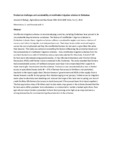Please use this identifier to cite or link to this item:
https://cris.library.msu.ac.zw//handle/11408/1715Full metadata record
| DC Field | Value | Language |
|---|---|---|
| dc.contributor.author | Mutambara, S. | - |
| dc.contributor.author | Munodawafa, Adelaide | - |
| dc.date.accessioned | 2016-07-22T13:19:25Z | - |
| dc.date.available | 2016-07-22T13:19:25Z | - |
| dc.date.issued | 2014 | - |
| dc.identifier.issn | 2224-3208 | - |
| dc.identifier.uri | www.iiste.org/Journals/index.php/JBAH/article/download/14210/14518 | - |
| dc.identifier.uri | http://hdl.handle.net/11408/1715 | - |
| dc.description | Abstract | en_US |
| dc.description.abstract | Smallholder irrigation schemes in most developing countries, including Zimbabwe have proved to be unsustainable beyond external assistance. The history of smallholder irrigation schemes in Zimbabwe indicate these irrigation schemes suffered considerable neglect and were a mixture of success and failure during the post-independence era. Their importance in the semi-arid regions cannot be over emphasized yet they the smallholder farmers do not seem to give them the value they deserve. This study was aimed at unravelling the factors influencing the production levels and the sustainability of smallholder irrigation schemes. Three smallholder irrigation schemes from the southern Eastern Low-veld of Zimbabwe were purposively selected for the study. A total of 130 farmers were interviewed using questionnaires, 11 key informant interviews and 3 Farmer Group Discussions (FGDs) with farmers were conducted in the 3 schemes. The study revealed that farmers had unsustainable sources of livelihood and poor asset base that compromised their capacity to make meaningful investments into the schemes. Production was unsustainably low due to limited access to agricultural inputs (only 40 – 67% of farmers had access to fertilizers and pesticides), inactivity in the input supply chain (the dominance of government and NGOs in the supply chain is biased towards specific farmer groups thus disadvantaging other groups), limited access to irrigation water (due to electricity load shedding and reduced discharge of the Save river in spring) and lack of credit facilities (0% farmers had access to bank loans and 17% accessed loans from input suppliers). The low application rates of fertilizers and the low value crops grown in the scheme showed that the farmers were still to graduate from subsistence to commercial or market oriented agriculture. Poor agricultural output markets prevented farmers from growing some high value crops and were a strong disincentive for commercialising the production in the schemes. | en_US |
| dc.language.iso | en | en_US |
| dc.publisher | IISTE | en_US |
| dc.relation.ispartofseries | Journal of Biology, Agriculture and Healthcare;Vol.4, No.15 | - |
| dc.subject | Production level, Smallholder irrigation schemes, Sustainability | en_US |
| dc.title | Production challenges and sustainability of smallholder irrigation schemes in Zimbabwe | en_US |
| dc.type | Article | en_US |
| item.fulltext | With Fulltext | - |
| item.languageiso639-1 | en | - |
| item.openairecristype | http://purl.org/coar/resource_type/c_18cf | - |
| item.grantfulltext | open | - |
| item.openairetype | Article | - |
| item.cerifentitytype | Publications | - |
| Appears in Collections: | Research Papers | |
Files in This Item:
| File | Description | Size | Format | |
|---|---|---|---|---|
| Mutambara, Munodawafa.pdf | 216.34 kB | Adobe PDF |  View/Open |
Page view(s)
168
checked on Oct 9, 2025
Download(s)
72
checked on Oct 9, 2025
Google ScholarTM
Check
Items in MSUIR are protected by copyright, with all rights reserved, unless otherwise indicated.



